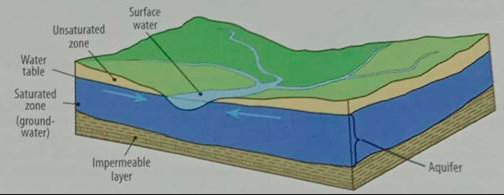The term etymologically comes from the latin, “aqua’ for water, plus “fer’ for bearing or ‘water bearing.’ It refers to permeable rock or other materials, such as gravel, sand or silt, that can hold and allow groundwater to move underground. Precipitation seeps through the soil to accumulate as an aquifer, which can resurface through springs or wells, or can be accessed through wells.

It is a critical characteristic of subsurface materials for preserving and providing groundwater for all sorts of uses, including for drinking water, industry, and farming. For such purposes the aquifers serve as storehouses for water.
The risks are that we can use the underground water faster than it is replenished by rainwater so that the source dries up. Or we can pollute it by discharging toxic materials onto the soil that seep into the aquifer. Notable sources of pollution include overspraying pesticides and herbicides and leaking landfills.
Some further ideas to explore on Aquifers:
Where is the nearest aquifer to you that provides drinking water?
What are the risks to this aquifer from industry and farming?
Can aquifers be cleaned after becoming contaminated, and if so how?
Sources:
“Aquifer,” National Geographic Society. bit.ly/43ambI8
Water Science School, Aquifers and Groundwater. United States Geological society (USGS). bit.ly/3qmAhHN
Groundwater. US EPA. bit.ly/45ALmoY


No comments yet, add your own below